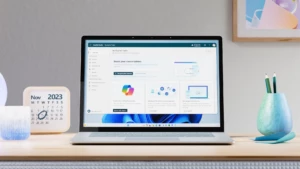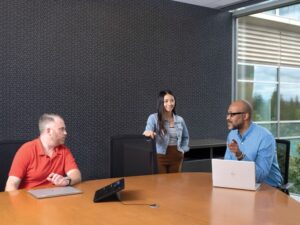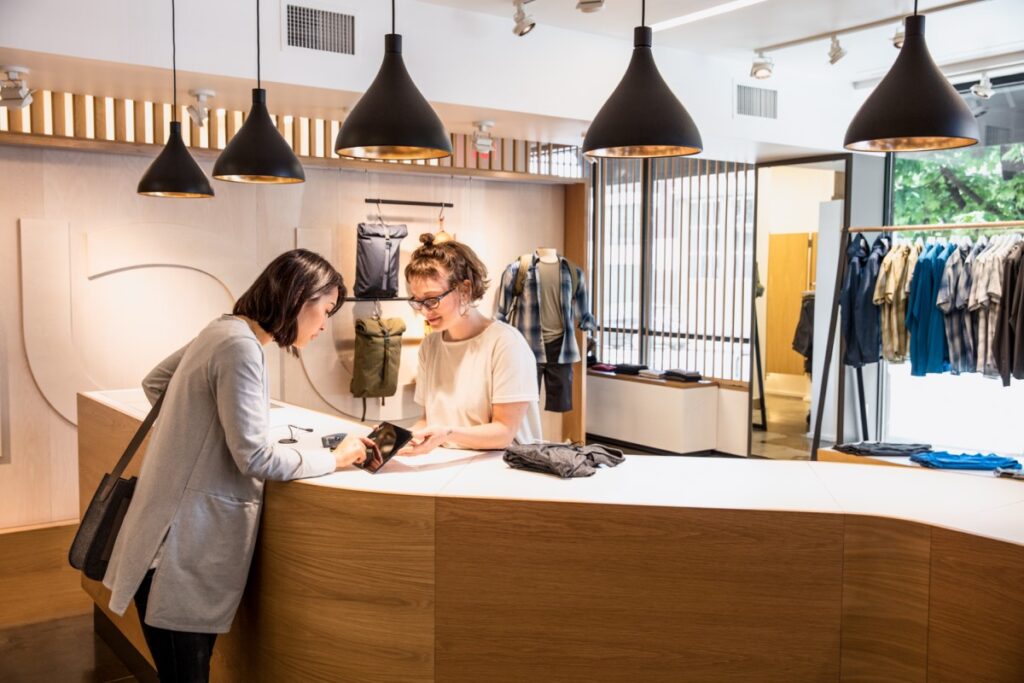
3 ways to support frontline workers in a hybrid world
When the working world split between those who could work from home and those who could not, the frontline transformed beyond anyone’s expectations. Frontline workers—the associates at the forefront of your customer interactions, the clinicians delivering patient care, and those running your operations on the ground—have long been underserved by technology and are only now becoming part of the same “future of work” conversation as information workers.
We know those on the frontline need the right digital tools and purpose-built hardware for the specific ways they work. So, the question becomes, how do we support the frontline workers and ensure they are included in the future of work conversations?
The answer lies in continuing to innovate in ways that seek to empower frontline workers with the right tools to give them a sense of purpose, the flexibility to adjust to the new day-to-day realities of a hybrid world, and the knowledge to make on-the-ground decisions to improve business outcomes.
When we do this, we empower frontline workers to not only keep up with the changes of a hybrid world but to stay ahead of them. In fact, we’ve seen more than a 150 percent increase in Microsoft Teams usage among frontline workers over the past year in industries such as retail, financial services, healthcare, and government. Let’s take a closer look at the three ways we are continuing to innovate for frontline workers.
1. Empower with a sense of purpose
Just like information workers, frontline workers equally want a sense of purpose—what does this job mean for them and how are they a part of their company? This is so important. We see a lot of employee turnover because frontline workers often feel disconnected—they don’t receive communications from the head office, they don’t know who they are working with, and they lack a strong sense of community. We think it is time to democratize company culture to bring your frontline workers closer—and not just because it’s a good thing to do—but because these employees are the faces of your company that impact your bottom line. And when employees feel they have a purpose, their loyalty increases, and they provide better services to your customers. An engaged employee equals better business results. In fact, according to research from Gallup, companies with an engaged workforce have a 10 percent increase in customer loyalty and 23 percent higher profitability versus those with a disengaged workforce.
Recreational Equipment, Inc. REI wanted to do just that with their frontline workers, or as they call them, their ‘green vest’ employees.
“Connecting employees across the co-op and across the country used to be difficult,” says Chris Grey, Director of IT Infrastructure Engineering Services, REI. “With Yammer integrated in Teams, frontline workers have a newfound ability to connect with colleagues from different areas of the business. It’s opened up a lot of opportunity.”
Green vest employees access Yammer via Teams to create groups aligned around topics like hiking and cycling. These groups connect employees from all over the company for networking and culture building.
“For the first time, retail employees and headquarters employees can easily chat about shared interests.”—Joey Northcott, Divisional Vice President of Technology Services, REI.
It’s important to connect corporate headquarters to frontline workers—whether it’s a Chief Executive Officer video of the week, communications about new policies, or sharing opportunities for employees to contribute ideas and feedback. Connecting your entire workforce so they can work together on shared goals is critical to your company’s success. Now, with the general availability of Viva Connections mobile coming next month, this connected relationship becomes easier and more inclusive. Viva Connections delivers a single, company-branded destination for frontline workers to access company news, tasks, resources, shifts, and more in the flow of their work. This helps give the entire workforce, from frontline to corporate, the ability to access news and participate in the company culture like never before.
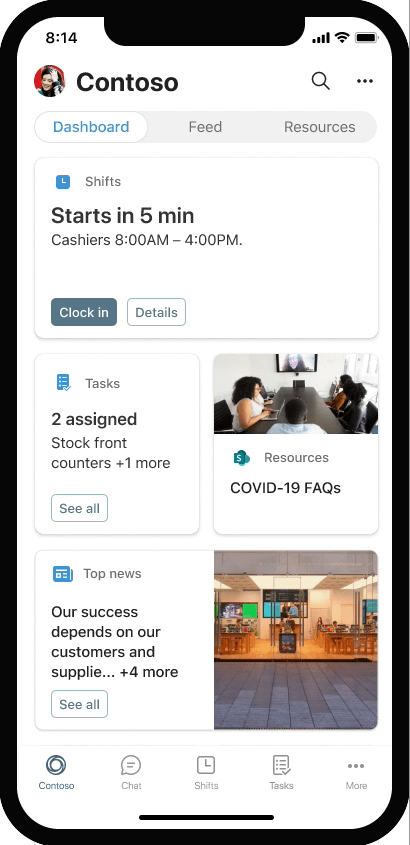
Viva Connections mobile is generally available coming next month.
Another aspect of creating a sense of belonging and purpose at a company is recognizing employees for a job well done. Many frontline workers have felt this from every angle over the past year, whether it be the public recognition displayed around the world or co-workers just reaching out to support each other. During the pandemic, we saw apps such as Praise grow in usage over seven times from pre-pandemic levels for frontline workers.1 Praise enables employees to encourage each other, thank peers for their support, and foster a positive culture.
2. Provide tools that enable flexibility
Think about the reality of a frontline worker’s day-to-day experience in a hybrid world. Day one the worker could be on the floor engaging with customers. Day two they could be in the warehouse fulfilling curbside orders. Day three they could be at home interacting with customers through virtual consultations and enabling sales through e-commerce.
Today’s workers aren’t just sitting at one station or always on the floor—they need the ability to stay connected as they move within the hybrid workplace. They need flexibility in where, how, and when they work, along with effortless ways to easily determine the availability of colleagues, and purpose-built devices that allow them to work with their peers seamlessly. During the pandemic, we saw apps such as Shifts grow in usage over 10 times from pre-pandemic levels for frontline workers.2 With Shifts, frontline staff can view their team members’ schedules and request to swap shifts within the app, a process that traditionally required each employee to call or message their manager or a team member to inquire about availability. And that is exactly what Boots Opticians did. For them, flexibility means providing frontline workers with self-serving shift scheduling tools and reducing paper-based processes around task execution. Before Shifts, requesting time off involved providing a request in writing to store managers and waiting for them to acknowledge and approve the request manually.
“My colleagues love Shifts because they know their real-time schedule, and they do not have to react to inefficient, paper-driven processes.”—John Peterson, Store Manager, Boots Opticians.
The move to hybrid also saw a dramatic shift from in-person appointments to virtual visits. We first saw this in healthcare organizations where the need to safely see patients required rapid innovation in virtual care. And we continue to see several long-term benefits across other industries including in retail with customers like REI, who needed a way to recreate the personalized service and experience customers had in store. They developed Virtual Outfitting and through Microsoft Teams they can connect their green vest employees with customers face-to-face, noting that “more than 86 percent of our customers are extremely satisfied with virtual outfitting via Teams,” according to Dominque Morel, Divisional Vice President of Expertise, REI.
To enhance the virtual visit experience for every type of customer or patient, we continue to build solutions that reimagine the in-person components of an appointment into a digital one. With waiting room for virtual visits, you can ensure every customer or patient feels welcome. Additional new features include the ability to add your logo, personalized messaging, and real-time visit notifications. These notifications can help reduce no-shows and can be automatically linked to virtual visits scheduled through Microsoft Bookings. For healthcare organizations, SMS notifications can also be connected to an electronic health record (EHR) system. Customers and patients can also join their virtual visit from a mobile browser without needing to install an app—making the engagement process even more seamless.
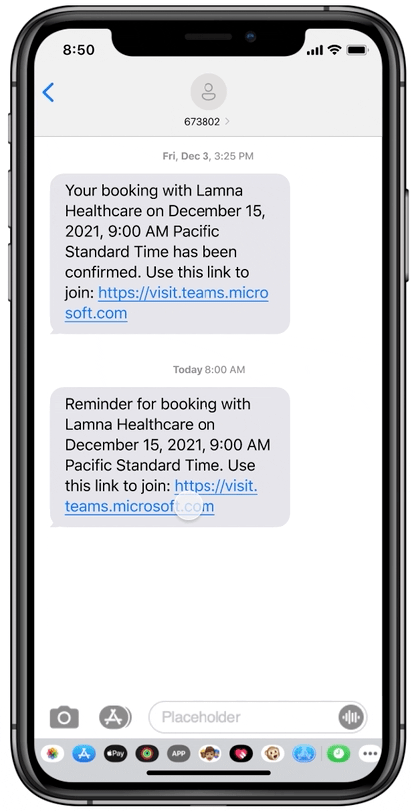
Waiting room is now in preview. SMS notifications are now generally available for Bookings and in preview for the Microsoft Teams EHR connector. Mobile browser join is now generally available.
Virtual visits provide a comprehensive view of appointments in one location—with real-time updates on wait times, missed appointments, staffing delays, streamline scheduling workflows to create a first-class experience for customers and patients. Schedulers can also send SMS and email reminders directly from the queue view to keep people up to date and can even use Microsoft Forms integration to secure patient or customer information prior to the visit.
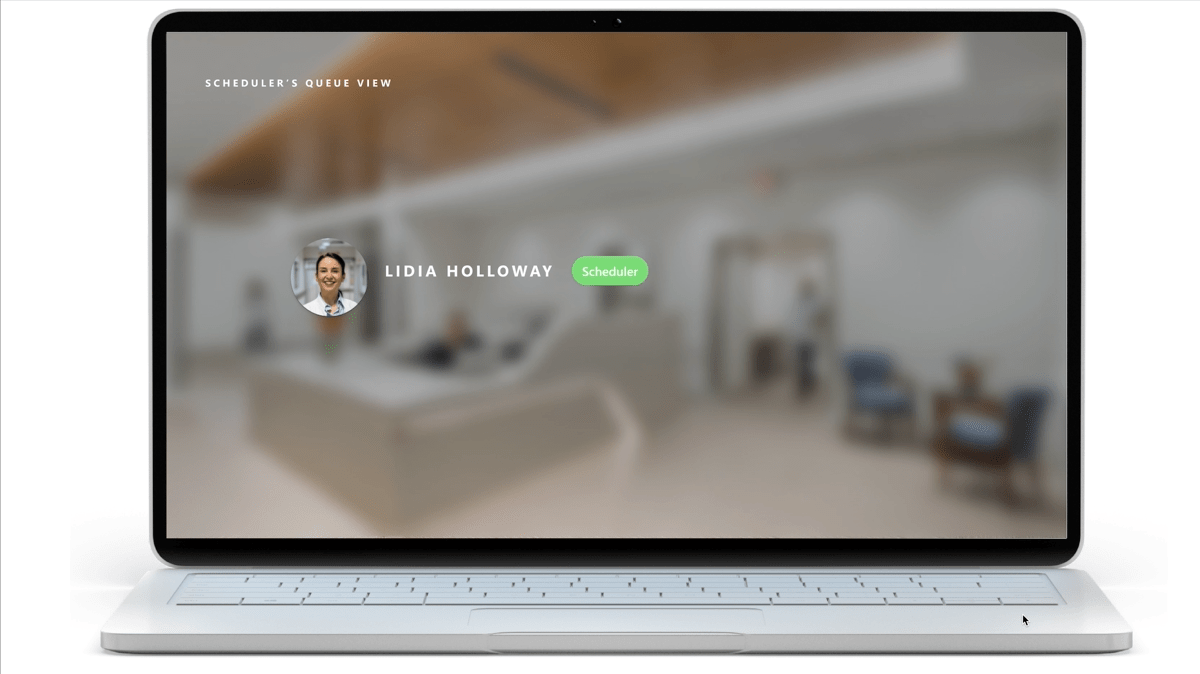
Scheduled queuing for virtual visits is now in private preview and Microsoft Forms integration to Bookings is now in private preview.
As virtual visits become even more of a commonplace in the daily workflows of healthcare frontline workers, we are excited to be extending the EHR connector to include the Cerner EHR for multi-participant virtual visits. This enables both providers and patients to access their virtual visits their way by enabling patients to launch virtual visits from their Cerner patient portal or from an SMS, with no app download required. Healthcare providers can also launch visits from Cerner PowerChart™.
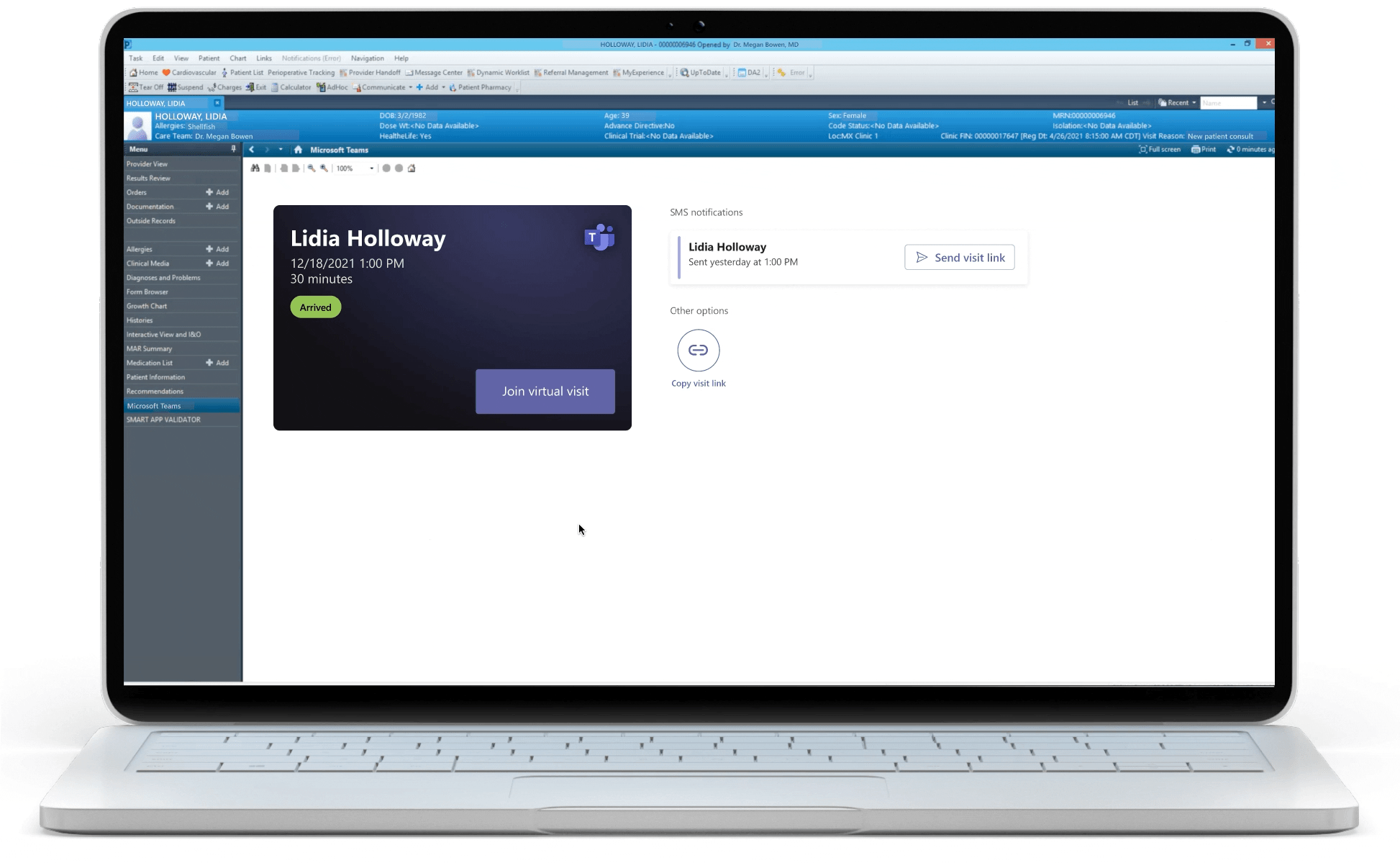
We invite you to join us at our upcoming, free health and collaboration virtual forum to learn more.
3. Equip frontline workers with the right knowledge
Last, but definitely not least, is empowering your frontline workers with access to the right knowledge. Traditionally underserved by technology, frontline workers’ workflows have largely been based around paper-based processes. Bringing the right tools and information directly to the fingertips of the frontline is essential. Frontline workers must be able to easily reach the right people, find the data they need to make educated decisions faster, and share insight and data with both immediate colleagues and leadership. When they have the right information at the right time, they can make the right decisions for your business and your customer.
Take Western Lakes Fire Department, who added the live stream of the drone footage to Teams, which could then be monitored from emergency vehicles, Incident Command Posts, or on-site whether on tablets, phones, or mobile data terminals.
“Lifesaving is a matter of minutes—seconds sometimes—and so that increased situational awareness we get from Teams and the drone just makes us faster and better at our job.”—Brad Ingersoll, Deputy Chief, Western Lakes Fire Department.
One process that has seen massive digital transformation is pivoting from in-person expertise to expert remote assistance, to provide real-time guidance and knowledge on the ground. We’re making these experiences seamless through Teams integration with devices that are tailor-made for frontline workers. For example, RealWear headsets enable access to the right experts in a heads-up, hands-free manner so workers can maintain situational awareness while getting detailed assistance from a colleague.
In keeping with this focus, we are announcing that RealWear will be the first device running Android Open Source Project (AOSP) supported by Microsoft Endpoint Manager—which now manages and protects devices that run AOSP. This means that organizations can easily configure RealWear devices for either shared or single-use by frontline workers and apply protection policies in Teams that help keep company information, and the knowledge passed between workers, even more secure.
“We’ve been closely collaborating with Microsoft Endpoint Manager over the last year and are so delighted to be the first supported Microsoft device partner.”—Sanjay Jhawar, Co-Founder and President, RealWear

We continue to improve Microsoft Endpoint Manager and Microsoft Azure Active Directory shared device mode to enable compliant, secure, and efficient shared device scenarios for the operating systems on which frontline workers depend for their information to do their job.
Knowledge is also not just about on-the-ground insights, but also very important when interacting with customers and patients. Take Marks and Spencer, who equip their frontline workers with Microsoft Teams to serve as the single collaboration hub where they do everything from checking stock to sharing product insights with colleagues.
“As retailers, the best place we can be is on the shop floor. With Surface Go devices and Teams, employees have the information they need at their fingertips to help customers and work more efficiently.”—Julia Palmer Bennett, Store Manager, Marks and Spencer.
Frontline workers often require the ability to make and receive approval requests—which can mean the difference between whether a machine equipment permit is ready or a shipment leaves on time. To complement our existing Adobe Sign integration, we are announcing the general availability of DocuSign as an Approvals partner coming next month. This partnership extends our electronic signature capabilities already in place in Teams today, allowing your workforce to create and send approval requests right in the flow of work. Integration of the Approvals App with Microsoft Word further streamlines the approval process so workers can create, manage, or request approvals directly from Teams or their Word documents.
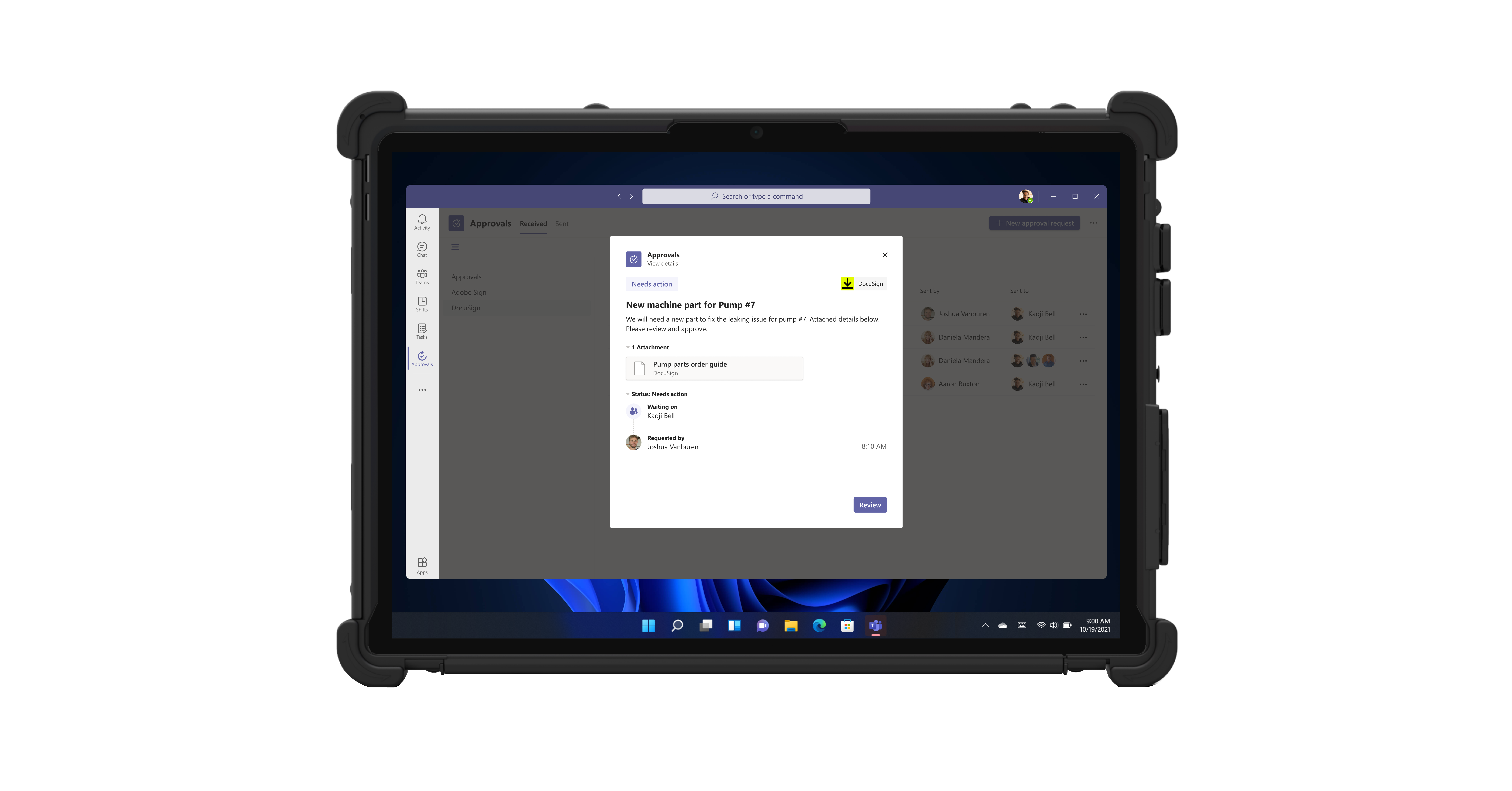
Learn more about the future of hybrid work for frontline workers
The bottom line is that frontline workers need to feel connected to their organization, they need flexible solutions that support the unique ways they work, and the right knowledge to execute on-the-ground decisions—especially for the hybrid world. Otherwise, businesses risk gaps in critical communication and may undermine the ability of frontline workers to meet the always-changing needs of the business. When all of your employees—from your information workers to your frontline workers—feel valued, are empowered with the right tools to do their jobs, and with the right culture to support them, they perform better. When your workers perform better, your whole business performs better.
Join me as I chat with Worklab Live host Elise Hu about how Microsoft is helping business leaders redefine the value frontline workers bring to their organization and what they need to successfully operate in the new world of hybrid. Tune in on Microsoft’s LinkedIn channel at 8:00 AM PST on October 19, 2021, or watch the video on demand here.
To learn how retail leadership is finding new ways to shift towards employee-centric business models to ensure they are the employer of choice for frontline workers, check out this retail blog from Shelley Bransten, Corporate Vice President, WW Retail and Consumer Goods Industry. We also know frontline workers are the backbone of the manufacturing industry—learn how manufacturing leaders are adopting new technology in this manufacturing blog by Colin Masson, Global Industry Marketing Director, Manufacturing.
We are here to help industries and frontline workers not only keep up but thrive in this hybrid world. Whichever industry you are in, be sure to check out our entire frontline solution available today and learn more about our new product innovations touched on today.
Interested to learn more about how Microsoft Teams can digitally empower your frontline workforce? Subscribe to our newsletter!
1January through June 2021.
2 January through June 2021.

